Smart features
THE ADVANTAGES AT A GLANCE
Smart features of ghostONE
ghostONE is much more than a conventional AC wallbox. The platform’s smart features and design in line with automotive standards offer your customers a wide range of benefits.
- Optimum utilisation of the photovoltaic system thanks to PV surplus charging, 3/1 phase switching and implementation of the ISO 15118 standard
Stabilisation of the grids (blackout protection) through integrated mini HEMS (load management)
Intelligent use such as authorisation, PV charging and over-the-air updates (OTA), etc. are also possible in offline mode (no cloud required)
Stable, sustainable and durable design - validated according to automotive standards & certified according to the respective country standards
WE ARE HERE FOR YOU
We would be happy to show you how your customers can benefit from our smart solutions.
SIMPLE INSTALLATION & NETWORKING
ghostONE pffers your customer secure, simple and cost-effective installation and initial configuration.
Quick & easy initial installation for the electrician
No access, passwords or software configurations are required for the initial installation by the electrician. The installer can carry out the electrical acceptance test, including the charging test, without having to log into apps, websites or similar. This saves an enormous amount of time during installation, and therefore money, and avoids queries about passwords, settings, etc. Sensitive data such as home network passwords do not have to be disclosed.
Initial configuration & networking
In order to fully utilise the smart features of the ghostONE wallbox, the wallbox needs to be networked. This can be done via an Ethernet cable, Wi-FI or LTE. The initial configuration can be carried out via the local hotspot and does not require any further networking such as a connection to the home network (Wi-Fi) – laying an Ethernet cable is therefore possible but not a must.
AUTHORISATION
Secure and simple authorisation
The ghostONE offers your customer several ways to protect the charging function of their wallbox from unauthorised access:
RFID
ghostONE enables a large number of RFID chips to be taught in to the box. This means that other family members or neighbours can charge at the wallbox with their own RFID chip – but not everyone who wants to.
AutoCharge
Your customer can charge their electric car by simply plugging it in – the electric car and the wallbox will recognise each other automatically. This is enabled by the full implementation of the ISO 15118 standard in the ghostONE.
Plug and charge
Plug and charge goes beyond the functionality of AutoCharge and offers maximum security and convenience thanks to encrypted communication in accordance with the ISO 15118 standard. In addition, Plug and Charge enables billing at public charging parks. This is made possible by the full implementation of the ISO 15118 standard in the ghostONE.
BILLING
Straightforward billing for private individuals, company cars and fleet shops
The ghostONE is available as a MID and calibration law-compliant version and is compatible with many backends for billing thanks to OCPP. This makes charging in semi-public and public spaces possible for your customers. In addition, charging is also possible in private spaces to separate company cars and private e-cars.
Use Case | Connectivity & Remote Control
Management of charging points with OCPP
- The wallbox enables remote control for the charge point operator, making wallbox management possible (authentication, authorisation, billing etc.)
- Integration of OCPP connection to the CPO-Backend
- Implementation of “Eichrecht”-conformity of the wallbox for billing according to German “Eichrecht”
PV-SURPLUS-CHARGING
Save costs and promote the energy transition by charging with photovoltaics
With so-called PV surplus charging, electric car drivers can supply all the consumers in their home, such as the washing machine, heat pump and refrigerator, with electricity from the photovoltaic system and use the surplus PV electricity to charge their electric car. However, as soon as the sun is obscured by a cloud, the amount of kW charged by the photovoltaic system is reduced. This would normally lead to the charging process being cancelled. The electric car driver would then have to either charge later or, in the worst case, use expensive grey electricity to continue charging – which is bad for electricity costs and bad for the energy transition. ghostONE offers two different solutions to this problem: in conjunction with an electric car, which also has the ISO 15118 standard integrated, ghostONE can dynamically regulate the current to the minimum values that can be realised by the car. A minimum charging power of 1.4 kW or less can therefore be realised without switching from 3 phase to 1, for example if a cloud moves in front of the sun. Switching would lead to a charging interruption of around one minute. As not all car manufacturers have yet implemented the ISO 15118 standard in their vehicles, the ghostONE also features 3/1 phase switching. Green electricity can thus be used intelligently and your customer’s electricity costs can be reduced.
Use Case | PV surplus charging
The electric car is charged with surplus PV electricity after the house and all its consumers have been supplied.
Securing the charging process when the PV surplus decreases
- Dynamic regulation of the current to the minimum values of the electric car through full implementation of ISO 15118 standard
- Standard-minimum charging power of 1.4 kW or less can be converted from 3 to 1 even without phase switching
Additional 3/1 phase switching integrated, as not all car manufacturers have yet implemented the ISO 15118 standard in their vehicles
SMART HOME INTEGRATION
Connected and cost-saving charging through smart home integration
In order to be able to integrate PV systems and heat pumps into the communication, ghostONE has integrated another standard in addition to ISO 15118: the EEBus protocol for smart home applications. This protocol is widely recognised in the energy, automotive and electrical industries. The PV system can use EEBus to tell a Home Energy Management System (HEMS) how much solar power is currently available. On this basis, the HEMS decides whether electricity needs to be added from the grid, and if so how much. Further integration of the wallbox into smart home applications is also possible via Modbus/TCP and REST.
Use Case | EEBUS Smart Home Integration
Intelligent charging features with EEBUS and HEMS
Example of optimised PV charging
- The PV system can use EEBus to tell a HEMS how much solar power is currently available. The charging plan decides on this basis whether electricity needs to be added from the grid, and if so how much.
EEBUS Smart Home Integration
- Private installations with EEBUS-HEMS and other EEBUS connected devices.
SECURING THE POWER GRID
Securing the electricity grid and reducing grid fees in accordance with Section 14a EnWG
Since 1 January 2024, German distribution grid operators have been obliged to reduce controllable consumption devices (SteuVE) down to 4.2 kW when necessary to benefit the grid. Together with an FNN control box, the ghostONE enables stepless dimming. The power output of the wallbox is reduced to as little as 4.2 kW – as required by § 14 EnWG (German Energy Industry Act). Digital communication takes place via the EEBUS standard, allowing control commands to be transmitted continuously and bidirectionally. This smart feature offers your customer a further opportunity to reduce their electricity costs: by participating in §14a EnWG, it is possible to reduce the cost component of grid charges, as the grid operator currently pays up to 110 to 190 euros per year for participation. In addition to the cost factor, your customer contributes to securing the grids and thus to the energy transition.
Use Case | Grid Convenience
Charging in accordance with of §14a EnWG with EEBUS
Grid Convenience
- Dynamic adjustment of charging power by limitations of the grid provider
- EEBUS as communication standard
- Dimming via FNN control box and Smart Meter Gateway (SMGW)
Added value for the customer
- Private installations with EEBUS-HEMS and other devices networked via EEBUS
- Grid convenience as essential feature for comprehensive charging infrastructure
- Preparation for upcoming regulations
LOAD MANAGEMENT
Securing the electricity grids through static or dynamic load management
If your customer is charging their electric car and using various household appliances at the same time, it can happen that all these processes draw more power from the grid than the main fuse allows. The same happens if several electric cars are charging at the same time using electricity from the same grid. This is where load management comes to the rescue so as not to overload the house’s main fuse, which would lead to a power cut. For load management, a household consists of non-controllable loads such as the washing machine, cooker, iron and TV and controllable loads such as the wallbox and heat pump. If load management only covers the controllable loads, this is referred to as static load management. The maximum available power is distributed among the controllable loads. If, for example, we consider an underground car park with four wallboxes and an available power of 64 kW – then each wallbox would have 16 kW available for charging the electric car. However, this does not take into account the washing machine, which is also located in the basement. If a load management system also covers the non-controllable consumers by analysing a central electricity meter, this is referred to as dynamic load management. This ensures that the house connection is not interrupted by the unforeseeable use of uncontrollable consumers. This usually requires a HEMS (ome Energy Management System), which can incur additional costs. The ghostONE has already solved this function, however, with an integrated mini HEMS and thus saves your customer additional costs and secures the house connection.
Use Case | Local static load management
(Mini HEMS)
A maximum charging capacity is distributed across several wallboxes (controllable consumers)
Local static load management (Mini HEMS)
- One wallbox acts as a local load management system (lead)
- It distributes the power according to grid limits
- Remaining wallboxes receive the limits using EEBUS

Use Case | Local dynamic load management
(Mini HEMS)
The maximum available power at the house connection is intelligently divided between non-controllable and controllable consumers
Local dynamic load management (Mini HEMS)
- The power of non-controllable loads such as washing machines and TVs is recorded by the smart meter. The remaining available power is then distributed among the controllable loads such as the wallbox.
- If several wallboxes are installed, one wallbox acts as a local load management system (lead).
- The controllable loads receive the limits using EEBUS.
DYNAMIC TARIFFS
Reduce electricity costs and promote the energy transition at the same time
Charging with photovoltaics, integration into the smart home and participation in §14a EnWG have already been mentioned as three of the ways in which ghostONE can help your customers to reduce their electricity costs and drive forward the energy transition. Another point is the topic of dynamic tariffs: in addition to your own photovoltaic power, you can also rely on green electricity from wind power, for example. However, this is not always available in sufficient quantities, for example when there is not enough wind to operate the wind turbines sufficiently. This means that electricity is more expensive at different times. If this is reflected in your electricity tariff, this is referred to as a dynamic tariff. To use the cheapest electricity, you need an intelligent charging system like the ghostONE to charge when the electricity is cheapest. And no, your customer doesn’t have to set an alarm clock to switch on the wallbox at the most favourable time. Our ghostONE does this all by itself via networking with energy management systems or cloud systems.
Use Case | Dynamic tariffs
Time-shifted charging according to dynamic tariffs
Charging low-cost green electricity with dynamic tariffs
- Green electricity costs different amounts at different times – this is called a dynamic tariff. To use the cheapest electricity, you need an intelligent charging system like the ghostONE to charge when the electricity is cheapest.
- ghostONE switches on the charging process at the most favourable time via networking to the HEMS or cloud system.
WEB APP & OVER THE AIR UPDATES
Simple operation via the WebApp & over-the-air updates (OTA)
The ghostONE has its own web app. It allows users to operate all smart functions intuitively and to monitor the charging status. The integrated system functions, such as the authorisation function or optimisation processes for PV surplus charging, can also be called up in offline mode via the web app. Internet or a cloud are not required.
The situation is different for updates. Internet access is required here. Underground car parks, for example, can have a poor mobile phone connection, or none at all, making it difficult to retrieve updates for the wallbox or the car. The ghostONE solves this problem quite simply, as the networked wallbox offers a Wi-Fi access point that can be used to install OTA updates for the vehicle even in underground car parks.
Use Case | Internet Access
Wi-Fi access point for the electric vehicle
Internet access for the electric vehicle
- Underground car parks often interfere with cellular network access
- Internet access is essential for updates
The wallbox acts as a Wi-Fi access point

CYBER SECURITY
Protection from hackers through optimised cyber security
Private charging stations are an easy target for cyber attacks. This is because most wallboxes are connected to the internet, including the ghostONE. In accordance with the European Radio Equipment Directive (RED), the ghostONE is protected from cyber attacks. The new RED measures cover the following targets:
Increasing the resilience of networks. Wireless devices and products must include features that prevent interference with communication networks and prevent the devices from being used to disrupt the functionality of websites or other services.
Better protection of consumer privacy: Wireless devices and products must have functions that guarantee the protection of personal data.
- Reducing the risk of money fraud: Wireless devices and products must include features that minimise the risk of fraud in electronic payments. For example, they must ensure better authentication control of the user in order to prevent fraudulent payments.
The extension directive published at the end of 2022 must be implemented from August 2025. In the coming years, basic security precautions that have long been standard in corporate networks or online banking will also be required in the consumer electronics world – and this includes wallboxes. ghostONE has already fully implemented the previously defined RED requirements and offers your customers optimum security.
VALIDATION & CERTIFICATION
Stable, sustainable and durable design - validated according to automotive standards & certified according to the respective country standards
Thanks to validation according to automotive standards, the ghostONE wallbox is equipped for all adversities, guaranteeing the user a stable design across the entire service life
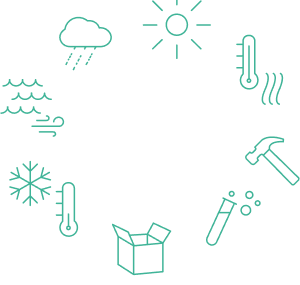
The ghostONE is tested for the following:
Water protection (IPX5) – even in pouring rain or snow, the ghostONE charges reliably for your customer
Dust protection (IP5KX) – even in desert areas, dust cannot harm it
Packaging test (ISTA) – the wallbox arrives safely at your customer’s premises
Salt spray test – charging with a view of the sea? No problem with ghostONE
Sun exposure – ghostONE is available in various colours that do not fade even in direct sunlight
Vandalism – we would like to have a peaceful world for our ghostONE – but it is also safe from troublemakers
Warm and humid climate – the ghostONE is tested up to a humidity of 95 per cent
Lifetime tests (HTOE/TWDL) in fast motion – the ghostONE will provide your customers with many years of loyal service
Chemical resistance – almost like Teflon – chemicals such as oil, acid, cleaning agents and bird droppings – our ghostONE is unaffected (testing of 28 chemicals for chemical resistance)
Low temperature resistance (-30 degrees) – after a long cold night, the ghostONE doesn’t need any warm-up time or coffee – it’s ready to use straight away
Certification
We take care of the certification for your desired target countries and thus save you time and reduce stress – so ghostONE is available to your customers even faster.
Have you got questions about the technologies used in the ghostONE?

Paul Bräuer
Sales
Phone: +49 7024 40598 0